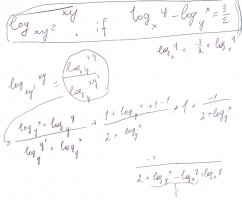[math]\log_{xy^2}{xy}[/math]=? if [math]\log_{x}{y}[/math] [math]-[/math][math]\log_{y}{x}[/math] [math]=[/math] [math]\frac{ 2 }{3 }[/math]answer: 3/5
i don‘t think that my way to solve this is at least somehow correct, though here it is, just in case
i don‘t think that my way to solve this is at least somehow correct, though here it is, just in case
Attachments
Last edited:

